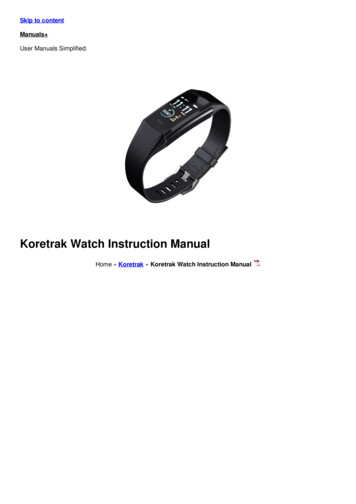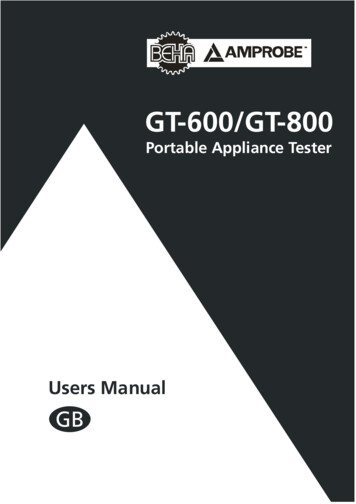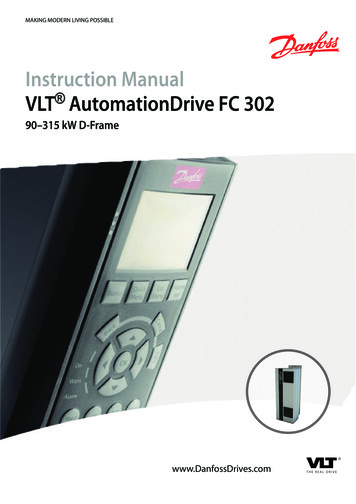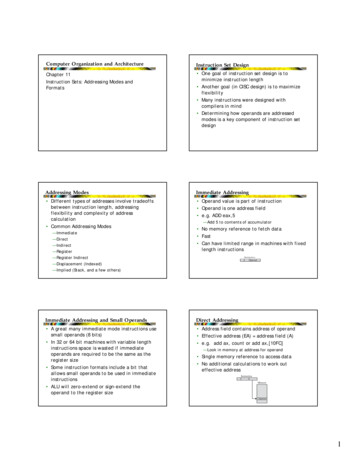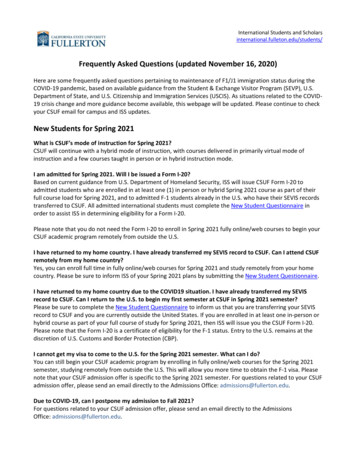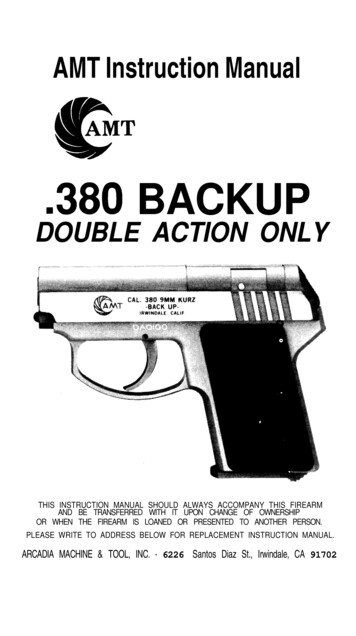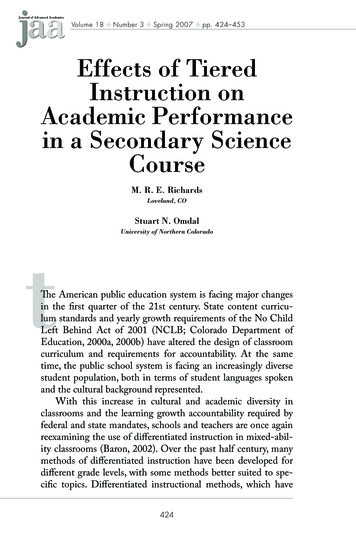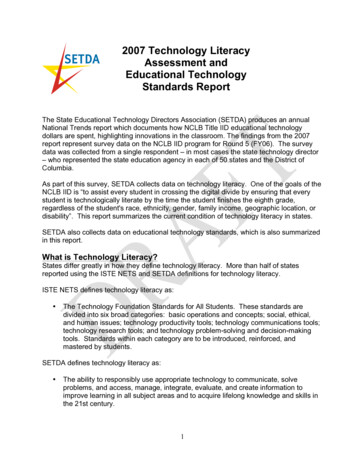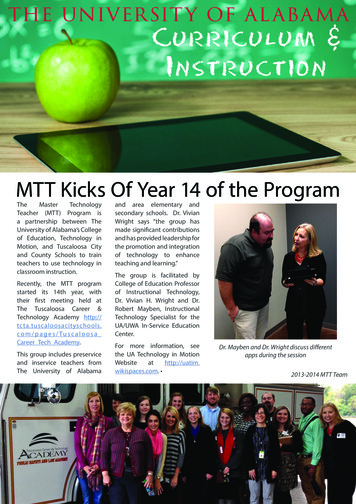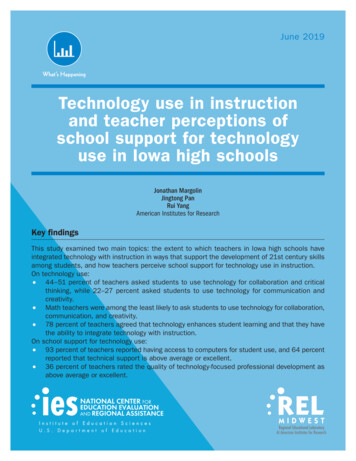
Transcription
June 2019What’s HappeningTechnology use in instructionand teacher perceptions ofschool support for technologyuse in Iowa high schoolsJonathan MargolinJingtong PanRui YangAmerican Institutes for ResearchKey findingsThis study examined two main topics: the extent to which teachers in Iowa high schools haveintegrated technology with instruction in ways that support the development of 21st century skillsamong students, and how teachers perceive school support for technology use in instruction.On technology use: 44–51 percent of teachers asked students to use technology for collaboration and criticalthinking, while 22–27 percent asked students to use technology for communication andcreativity. Math teachers were among the least likely to ask students to use technology for collaboration,communication, and creativity. 78 percent of teachers agreed that technology enhances student learning and that they havethe ability to integrate technology with instruction.On school support for technology use: 93 percent of teachers reported having access to computers for student use, and 64 percentreported that technical support is above average or excellent. 36 percent of teachers rated the quality of technology-focused professional development asabove average or excellent.U.S.DepartmentofEducationAt American Institutes for Research
U.S. Department of EducationBetsy DeVos, SecretaryInstitute of Education SciencesMark Schneider, DirectorNational Center for Education Evaluation and Regional AssistanceMatthew Soldner, CommissionerElizabeth Eisner, Associate CommissionerAmy Johnson, Action EditorErin Pollard, Project OfficerREL 2019–004The National Center for Education Evaluation and Regional Assistance conducts unbi ased, large-scale evaluations of education programs and practices that are supported byfederal funds, provides research-based technical assistance to educators and policymakers,and supports the synthesis and the widespread dissemination of the results of research andevaluation throughout the United States.June 2019This report was prepared for the Institute of Education Sciences (IES) under ContractED-IES-17-C-0007 by Regional Educational Laboratory Midwest administered by theAmerican Institutes for Research. The content of the publication does not necessarilyreflect the views or policies of IES or the U.S. Department of Education nor does mentionof trade names, commercial products, or organizations imply endorsement by the U.S.Government.This REL report is in the public domain. While permission to reprint this publication isnot necessary, it should be cited as follows:Margolin, J., Pan, J., & Yang, R. (2019). Technology use in instruction and teacher perceptionsof school support for technology use in Iowa high schools (REL 2019–004). Washington, DC:U.S. Department of Education, Institute of Education Sciences, National Center for Edu cation Evaluation and Regional Assistance, Regional Educational Laboratory Midwest.Retrieved from https://ies.ed.gov/ncee/edlabs.This report is available on the Regional Educational Laboratory website at http://ies.ed.gov/ncee/edlabs.
SummaryThe rural districts served by the Central Rivers Area Education Agency (Central RiversAEA)1 in Iowa have invested in technology to assist teachers in supporting the devel opment in students of the 21st century skills emphasized by the Iowa Core Standards.Central Rivers AEA and three high schools in its service area have raised several questionsabout technology use. They asked Regional Educational Laboratory Midwest to conduct adescriptive research study on how much teachers have integrated technology with instruc tion in ways that are believed to support the development of 21st century skills amongstudents and how teachers perceive school support for technology use in instruction.This study used data from a survey administered in 2017 in 26 public high schools in theCentral Rivers AEA service area.Three research questions concerned teacher use and perceptions of technology. Theyexamined how frequently teachers ask students to use technology in ways that are believedto support the development of the 21st century skills of collaboration, communication,creativity, and critical thinking; how much teachers perceive that technology enhancesstudent learning; and how much teachers believe that they have the ability to integratetechnology with instruction.Three research questions concerned school support for technology use. They examinedhow much schools provide technology infrastructure and support, how much teachers par ticipate in high-quality professional development on using technology to support instruc tion, and how much school leaders encourage classroom technology use.The findings indicate that the proportion of teachers asking students to use technology inways that are believed to support the development of 21st century skills differs across skills,subject taught, and years of teaching experience. Key findings on classroom technology useinclude: 89 percent of teachers reported that their students use technology almost daily orweekly. 44–51 percent of teachers asked students at least monthly to engage in at leasttwo different uses of technology for collaboration and critical thinking, while22–27 percent asked students at least monthly to engage in at least two differentuses of technology for communication and creativity. Math teachers were among the least likely to ask students at least monthly toengage in at least two different uses of technology for collaboration, communica tion, and creativity. Teachers with 4–9 years of teaching experience were the most likely to ask stu dents at least monthly to engage in at least two different uses of technology forcollaboration and creativity, and teachers with 20 or more years of teaching expe rience were the least likely.Most teachers believe that technology has specific benefits for student learning and thatthey can integrate technology with instruction. Key findings on teacher perceptions oftechnology include: 78 percent of teachers agreed or strongly agreed that technology enhances studentlearning. Science teachers, career and technical education teachers, and worldi
language teachers were the most likely to agree, and arts teachers and math teach ers were the least likely.78 percent of teachers agreed that they have the ability to integrate technologywith instruction. Science teachers and teachers with 4–9 years of teaching experi ence were the most likely to agree.Most teachers have access to computers, the Internet, and adequate technical support butlimited access to technology-focused professional development. Key findings on schoolsupport for technology use include: 93 percent of teachers reported that they could access computers for their students’use all the time. 64 percent of teachers rated technical support as above average or excellent. The typical range for the total number of hours of technology-focused professionaldevelopment that teachers participated in over the last year was 1–8 hours. 36 percent of teachers rated the quality of technology-focused professional devel opment as above average or excellent. About 50 percent of teachers indicated that they discuss technology in profession al settings more than half the time or all the time.Although teachers use classroom technology frequently, they are not consistent in usingit in ways that are believed to support the development of 21st century skills among stu dents and may need additional support and encouragement. Math teachers, in particular,may need additional professional development in how to use technology to address spe cific learning objectives. Teachers with 3 or fewer years of teaching experience and thosewith 20 or more years also appear to need additional training on using technology forinstruction. School leaders planning technology-focused professional learning may wishto consider sustained approaches embedded in teachers’ ongoing professional responsibil ities rather than intermittent approaches. To this end, school leaders may consider usingsuch formal settings as departmental meetings, evaluations, and classroom observations forreflection and planning to reinforce their vision for technology use.ii
ContentsSummaryiWhy this study?1What the study examined2What the study foundMost teachers report that students use technology in the classroom almost daily or weeklyBetween 22 percent and 51 percent of teachers asked students at least monthly to usetechnology to promote skills of collaboration, communication, creativity, and criticalthinkingMath teachers and teachers with the most years of teaching experience were the least likelyto ask students to use technology in ways that are believed to support the developmentof 21st century skillsNearly four in five teachers agreed that technology enhances student learning and that theyhave the ability to integrate technology with instructionMost teachers reported having access to computers and websites needed for student useA majority of teachers rated technical support as above average or excellent, but fewer thanhalf of teachers rated technology-focused professional development as above average orexcellentMore than half of teachers reported spending 1–8 hours in technology-focused professionaldevelopment during the past yearHalf of teachers reported that discussions of instructional technology occur frequently55681215151616Implications of the study findings18Limitations of the study19Appendix A. Study methodologyA-1Appendix B. Descriptive statisticsB-1Appendix C. Survey response frequenciesC-1Appendix D. Summary of tests for mean differencesD-1Appendix E. Survey items analyzed in the studyE-1NotesNotes-1ReferencesRef-1Boxes1Previous research on school support for technology use and teacher perceptions ofschool support for technology use2Data and methodsiii23
Figures1Nearly 9 in 10 teachers reported that students use classroom technology almost dailyor weekly52Between 22 percent and 51 percent of teachers asked students at least monthlyto engage in at least two different uses of technology related to collaboration,communication, creativity, and critical thinking63Between 7 percent and 62 percent of teachers asked students at least monthly tocollaborate online in various ways74Between 5 percent and 35 percent of teachers asked students at least monthly to usetechnology to communicate in various ways75Between 13 percent and 37 percent of teachers asked students at least monthly to usetechnology to create various types of products86Between 24 percent and 62 percent of teachers asked students at least monthly to usetechnology for critical thinking in various ways97Math, arts, and physical education teachers were the least likely to ask students atleast monthly to use technology for collaboration98Math teachers were the least likely to ask students at least monthly to use technologyfor communication109Math teachers were the least likely to ask students at least monthly to use technologyfor creativity1110 Science teachers and career and technical education teachers were the most likely toask students at least monthly to use technology for critical thinking1111 Teachers with 4–9 years of teaching experience were more likely than teacherswith 20 or more years of teaching experience to ask students at least monthly to usetechnology for collaboration1212 Teachers with 4–9 years of teaching experience were more likely than teachers with20 or more years of teaching experience to ask students at least monthly to use oftechnology for creativity1313 Nearly four in five teachers agreed that technology enhances student learning andthat they have the ability to integrate technology with instruction1314 Science teachers were the most likely to agree that technology enhances student learning 1415 Science teachers were the most likely to agree that they have the ability to integratetechnology with instruction1516 About 64 percent of teachers rated as above average or excellent the quality oftechnical support from their school, whereas 36 percent of teachers rated as aboveaverage or excellent the quality of technology-focused professional development1617More than half of teachers reported spending 1–8 hours in technology-focusedprofessional development during the past year1718 Half of teachers reported that discussions of instructional technology occur frequentlyin professional settings17A1 Core subject teachers were more likely to respond to the survey than non–core subjectteachersA-7TablesA1 Topics addressing each research question and the number of survey items per topicA-1A2 Means and standard deviations of school-level indicators, by survey response status, 2016/17 A-4A3 Results of logistic regression examining school-level indicators predicting surveyparticipationA-5iv
ns, means, and standard deviations between school-level teacher responserate and scales related to technology useNumber of teacher respondents, by teacher and school characteristicsNumber of participating schools, by size, Title I status, and localePercentage of teachers reporting frequency of student use of classroom technology, byteacher and school characteristicsPercentage of teachers asking students at least monthly to engage in technology usefor collaboration, by number of technology uses and teacher and school characteristicsPercentage of teachers asking students at least monthly to engage in technology use forcommunication, by number of technology uses and teacher and school characteristicsPercentage of teachers asking students at least monthly to engage in technology usefor creativity, by number of technology uses and teacher and school characteristicsPercentage of teachers asking students at least monthly to engage in technologyuse for critical thinking, by number of technology uses and teacher and schoolcharacteristicsPercentage of teachers reporting agreement or disagreement that technology enhancesstudent learning, by teacher and school characteristicsPercentage of teachers reporting agreement or disagreement that they are able tointegrate technology with instruction, by teacher and school characteristicsPercentage of teachers reporting access to computers, by frequency of access andteacher and school characteristicsPercentage of teachers reporting that school Internet filters prevent access to neededwebsites, by frequency of blocking and teacher and school characteristicsPercentage of teachers reporting on perceived technical support quality, by perceivedquality of support and teacher and school characteristicsPercentage of teachers reporting on perceived quality of technology-focusedprofessional development, by perceived quality and teacher and school characteristicsPercentage of teachers reporting technology-focused professional development time, byhours spent and teacher and school characteristicsPercentage of teachers reporting on frequency of technology discussions, by frequencyof discussion and teacher and school characteristicsChi-square tests of goodness of fit for proportions of teachers using technology tosupport 21st century skills, by skill and teacher and school characteristicMean difference tests, by survey topic and teacher and school 9C-10C-11C-12C-13D-1D-2
Why this study?There is growing national consensus on the need for education systems to prepare studentsto succeed in the work environments and society of the 21st century (Partnership for 21stCentury Skills, 2009; see Voogt & Roblin, 2012, for a review). Recognizing this need, ateam of Iowa educators and business representatives identified a set of skills essential for21st century success (Iowa Department of Education, n.d.). Based on that work, the IowaCore Standards were recently revised to emphasize the following skills related to learningand innovation: Collaboration: working within and across personal and global networks to achievecommon goals. Communication: sharing information through multiple means, including visual,digital, verbal, and nonverbal interactions, leading to an accurate exchange ofinformation and ideas. Creativity: generating new or original thoughts, interpretations, products, works,or techniques. Critical thinking: accessing and analyzing key information to develop solutions tocomplex problems that may have no clear answer.Technology can connect students with learning opportunities for developing and practic ing these skills (Voogt, Erstad, Dede, & Mishra, 2013). Specifically, it can engage studentsin activities that develop collaboration, communication, creativity, and critical thinking.Examples of such student activities include: Collaborating online with students at other schools. Writing online reviews, blog posts, and constructive comments. Creating art, music, movies, or webcasts using technology. Collecting and analyzing data from online sources.Iowa school districts have invested in technology to address the Iowa Core Standardsexpectations for 21st century skills. For example, the rural districts served by the CentralRivers Area Education Agency (Central Rivers AEA)2 have provided a tablet or laptop forevery student and teacher.To promote effective technology use, Central Rivers AEA and three high schools in itsservice area formed the Iowa Learning and Technology Networked Improvement Commu nity (Iowa NIC) in partnership with Regional Educational Laboratory (REL) Midwest. Inspring 2017 the Iowa NIC began testing strategies to help high school educators understandhow technology can enhance teaching and learning. Along with these efforts, Iowa NICparticipants raised several questions about technology use in their schools. They asked RELMidwest to conduct a descriptive research study on how much teachers in schools such astheirs integrate technology with instruction in ways that are believed to support the devel opment of 21st century skills among students and on how teachers perceive school support inthree areas that promote technology use in instruction (these areas are described in box 1).The study findings were expected to show the Iowa NIC participants whether teacherswere using technology in the ways envisioned by the Iowa Core Standards, how muchschool support is available to teachers, how much teachers believe that they have theability to integrate technology with instruction, and how much they believe that doing soenhances learning.1
Box 1. Previous research on school support for technology use and teacherperceptions of school support for technology useThree critical school supports for instructional technology use are technology infrastructure,opportunities for professional learning, and encouragement by school leaders (Valiente, 2010).A robust technology infrastructure ensures that computer use is reliable and that technicalproblems can be quickly addressed. Technology infrastructure includes broadband Internetaccess, wireless network connectivity, computing device access, and technical support forteachers. School districts must also ensure appropriate website filtering policies so that stu dents can reliably access the websites they need for class assignments. Teachers who knowthat their students can reliably access devices and the Internet are more likely to plan lessonsthat incorporate digital resources (Argueta, Huff, Tingen, & Corn, 2011; Center for Promise,2013; Inan, Lowther, Ross, & Strahl, 2010; Valiente, 2010).High-quality professional learning opportunities help teachers integrate technology withinstruction in ways that support the development of 21st century skills among students(Argueta et al., 2011). Sporadic training sessions on how to use devices and software areunlikely to support technology integration in ways that enhance the effectiveness of instruction(Center for Public Education, 2013; Kopcha, 2012). But professional development sustainedthroughout the school year and embedded in the school day (for example, through mentoring)is associated with changes in teachers’ instructional technology practices (Duran, Brunvand,Ellsworth, & Şendağ, 2012; Scott & Mouza, 2007).Encouragement by school leadership can prompt teachers to use technology in studentcentered practices that support the development of 21st century skills (Anderson & Dexter,2005; Inan et al., 2010; Zhao & Frank, 2003). School leaders need to communicate how theyexpect teachers to use technology. Opportunities for professional discussion, reflection, andfeedback in existing school routines, such as departmental meetings, evaluations, and class room observations are also critical (see Davies & West, 2014, and Lawless & Pellegrino, 2007,for reviews).In addition to school supports, teachers’ own perceptions of technology are associatedwith technology use. To the extent that teachers perceive technology in instruction as directlyrelevant to their curriculum goals (Ertmer, Ottenbreit-Leftwich, Sadik, Sendurur, & Sendurur,2012) and favorable to student learning (Hur, Shannon, & Wolf, 2016), they are likely to inte grate it. And teachers’ confidence in their ability to integrate technology with instruction is asso ciated with their likelihood of doing so (Anderson, Groulx, & Maninger, 2011; Hur et al., 2016).Both school and teacher factors influence teacher perceptions of technology integrationwith instruction. School factors include enrollment size and student composition. Teachers insmaller schools (Hsu, Wu, & Hwang, 2007) and teachers in schools with a higher proportionof economically disadvantaged students (Perrotta, 2013) have more positive beliefs about thepotential benefits of technology use. Teacher factors include subject taught and years of teach ing experience. Different subjects vary in how they are supported by technology, so subjecttaught is likely to influence perceptions (Howard, Chan, Mozejko, & Caputi, 2015; Perrotta,2013). Years of teaching experience is negatively associated with teachers’ confidence in theirability to integrate technology (Inan & Lowther, 2010; Liu, Ritzhaupt, Dawson, & Barron, 2017).What the study examinedThe study used data from a survey about technology use for instructional purposes, schoolsupport for technology use, and teacher beliefs and attitudes that was administered in 20172
by the Central Rivers AEA to 26 public high schools in its service area. Six research ques tions in two broad categories guided the study:On technology use How frequently do teachers ask students to use technology in ways that arebelieved to support the development of the 21st century skills of collaboration,communication, creativity, and critical thinking among students? How much do teachers perceive that technology enhances student learning? How much do teachers believe that they have the ability to integrate technologywith instruction?On school support for technology use How much do schools provide technology infrastructure and support? How much do teachers participate in high-quality professional development onusing technology to support instruction? How much do school leaders encourage classroom technology use?The study reports findings across all responding teachers and across groups of teachersclassified by: Subject taught. Years of teaching experience. School size. School Title I status.3The study team conducted a statistical analysis to identify group differences. See box 2 fora summary of the data and methods and appendix A for details.Box 2. Data and methodsInstrument and dataThe study used data collected in 2017 through the Clarity Technology and Learning Survey ofteachers, an instrument included within an online school management system. Central RiversAEA provides all schools with access to this system for monitoring and supporting instructionaltechnology practices. The survey includes 132 items related to four domains: access to tech nology resources, teacher technology skills, classroom technology practices, and the schooltechnology environment. Forty-five of these items related to the study’s research questionsand topics (see appendix A for a description of topics and items).The survey covered 11 topics, each of which was associated with one or more survey items(see table A1 in appendix A). For each research question, the survey team examined respons es for one or more topics. For example, for the research question about school leaders encour aging classroom technology use, the study team examined responses for two topics: frequencyof discussions of technology use and overall perception of whether the school encouragestechnology use. The topic of frequency was associated with three survey questions, and thetopic of overall perception was associated with one survey question.Subject taught and years of teaching experience were determined based on teachers’ surveyresponses. School size and Title I status were determined based on publicly available data.(continued)3
Box 2. Data and methods (continued)Survey sampleAll high schools in the service area of the Central Rivers Area Education Agency (Central RiversAEA) have access to the Clarity Technology and Learning Survey. In 2017 the Central RiversAEA communicated with all high schools to remind them of the survey’s availability. Eachschool decided whether to administer the survey to its teachers and chose how to encourageteacher participation. The Central Rivers AEA shared deidentified data from the survey for2017 with the study team.Of the 57 high schools in the Central Rivers AEA service area, 26 administered the surveyin 2017, for a school response rate of 46 percent. Of 792 possible respondents at those 26schools, 524 teachers responded, for a response rate of 66 percent. Survey respondentsrepresented a range of subjects taught and years of teaching experience, and they belonged toschools that differed in size, Title I status, and locale (see table B1 in appendix B).Analysis of nonresponse biasSchools that administered the survey were compared with schools that did not on school-levelacademic proficiency, demographics, graduation rates, attendance rates, and college enroll ment rates. None of these variables was related to whether a school administered the survey(see table A3 in appendix A). Furthermore, among responding schools, the teacher responserate at a school was not significantly correlated with survey topics related to technology use orperceptions of technology use (see table A4 in appendix A).Teacher response rates differed significantly by subject taught, with teachers in core sub jects (math, English language arts, science, and social studies) most likely to respond to thesurvey (see figure A1 in appendix A). To account for the possible bias introduced by differencesin participation rates by subject taught, the subsequent survey analysis examined whetherresponses differed by subject taught.Data analysisThe study team performed preliminary analyses to determine whether the survey items in eachtopic could be combined to form a reliable and valid measure, meaning that the individualsurvey items are closely related and measure a single topic. The study team found that itemsfor the four 21st century skills (collaboration, communication, creativity, and critical thinking)could not be combined to form reliable measures but that items for the following topics could:teacher beliefs about how much technology enhances student learning, teacher beliefs abouthow much they have the ability to integrate technology with instruction, quality of technicalsupport, duration of technology-focused professional development, quality of technologyfocused professional development, and frequency of discussions of technology use. Therefore,the study team treated the survey data with two different approaches: reporting raw frequen cies and proportions for the four 21st century skills items and for the topics for which therewas a single survey item and reporting numerical scale scores for the other topics.The study team examined the frequency of teacher responses to the items addressing tech nology use for the development of the four 21st century skills. The study team also calculatedthe proportion of teachers emphasizing each skill, defined as asking students at least monthly toengage in two or more uses of technology for a given skill, for all teachers and for groups of teach ers classified by subject taught, years of teaching experience, school size, and school Title I status.The study team performed additional tests to determine which groups differed in their responses.(continued)4
Box 2. Data and methods (continued)For the topics for which a reliable scale score could be calculated, the study team cat egorized respondents according to the response option they were most likely to select forthe topic. These categorizations were used to describe the pattern of findings for each topic.The study team tested whether the mean scale scores of groups of teachers differed sig nificantly (using a one-way analysis of variance) and performed additional tests to determinewhich groups of teachers differed in their responses for a given topic. The study team did notexamine differences by school locale because a large proportion of schools were classified asrural (73 percent) or town (19 percent) (see table B2 in appendix B).What the study foundThe proportion of teachers asking students to use technology in ways that are believed tosupport the development of 21st century skills differs by skill and across subjects taughtand years of teaching experience. Most teachers believe that technology enhances studentlearning and that they have the ability to integrate technology with instruction. Mostteachers have access to computers, the Internet, and adequate technical support but limitedaccess to technology-focused professional development. About half of teachers reportedthat discussions of classroom technology use occur frequ
Math teachers were among the least likely to ask students to use technology for collaboration, communication, and creativity. . Most teachers reported having access to computers and websites needed for student use 15\n . A majority of teachers rated technical support as above average or excellent, but fewer than \nhalf of teachers rated .
